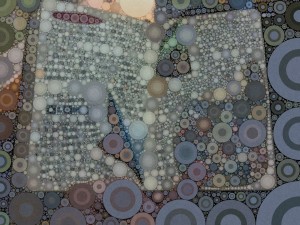
 The always fabulous Jude Marie Green mailed me. Her question, which got me thinking, was: What does an editor do (besides acquire) to make the issue “come together”?
The always fabulous Jude Marie Green mailed me. Her question, which got me thinking, was: What does an editor do (besides acquire) to make the issue “come together”?
It wasn’t the first time this question’s come up, and I’ve never seen much about it, so I wanted to talk a little about the idea of arranging things. Because an ideal magazine issue or anthology isn’t just a bunch of stories in a box. In theory, at least, the editor has selected stories that resonate with each other and arranged them in a way that’s meaningful. The whole is greater than the sum of the parts.
Here’s the only practical thing I’ve ever heard on the subject: Lead with your strongest story, and end with your second strongest. That seems like good advice to me, because a) first impressions flavor the way they’ll read what follows and b) at the end, you want the reader left feeling satisfied (or intrigued or delighted, but hopefully a favorable adjective, rather than let-down, disappointed, or relieved that the book is over.)
Beyond that – and this is entirely my philosophy and there are no guarantees any other editor feels the same – you want the stories to speak to each other. I’ve mentioned in another post that I used what was then a forthcoming collection, Near + Far, as an exercise for my online editing class. I gave the students the stories and told them to figure out an order and then be prepared to explain why they picked that order. Since there were actually two sections of the book, they actually did two ToCs, one for the “Near” part, which contained only near-future SF, and one for the “Far” part, which was devoted to SF farther out in time. It was enlightening (and sometimes entertaining) and I used that feedback when determining the actual order.
So here’s what I think about when arranging stories:
Some of these seem contradictory? Yup. Putting something like this together is a balancing act, and answers to what should go where are often dependent on what’s already been decided. Next time, I’ll go through the final versions of the ToCs for Near + Far and talk about why they’re in the order they are. Hopefully, that will show some of this in action.
Enjoy this insight into editing and want more content like it? Check out the classes Cat gives via the Rambo Academy for Wayward Writers, which offers both on-demand and live online writing classes for fantasy and science fiction writers from Cat and other authors, including Ann Leckie, Seanan McGuire, Fran Wilde and other talents! All classes include three free slots.
Prefer to opt for weekly interaction, advice, opportunities to ask questions, and access to the Chez Rambo Discord community and critique group? Check out Cat’s Patreon. Or sample her writing here.
...

NEAR:
The Mermaids Singing, Each To Each (Clarkesworld)
Peaches of Immortality (originally appeared as The Immortality Game in Fantasy)
Long Enough and Just So Long (Lightspeed)
Therapy Buddha (20/20 Visions)
Do the Right Thing (unpublished)
10 New Metaphors for Cyberspace (Abyss & Apex)
Memories of Moments, Bright As Falling Stars (Talebones)
RealFur (Serpentarius)
A Man And His Parasite (unpublished)
Not Waving, Drowning (Redstone)
Flicka (Subversions)
Raven (Twisted Cat Tales)
Legends of the Gone (Talebones)
FAR: (much less sure about this order, suggestions welcome)
Zeppelin Follies (Crossed Genres)
Surrogates (Clockwork Phoenix 3)
Kallakak's Cousins (Asimov's)
Five Ways to Fall in Love On Planet Porcelain (unpublished)
Angry Rose's Lament (Abyss & Apex)
Fire on the Water's Heart (Membrane)
Amid the Words of War (Lightspeed)
I Come From the Dark Universe (unpublished)
Seeking Nothing (Daily SF)
Bots d'Amor (Abyss & Apex)
TimeSnip (Basement Stories)
Mother's World (Aberrant Dreams)
(If you're curious about any, all of the online ones are linked to on my fiction page – http://www.kittywumpus.net/blog/fiction/. I know there's at least one A&A link that's broken, glad to hear of any other broken links.)
I've left some stories out, because there's actually enough for a 2nd fantasy antho and a horror one, much to my surprise. I've been more prolific over the past few years than I'd realized.
In my utter arrogance, I am debating whether or not I need to hire an editor, which is normally something I'd urge anyone putting together something for self-publishing to do. My reasoning is a) most of these have undergone multiple editing passes for publication, b) I am pretty sure I can find at least one volunteer proofreader, and c) I will be doing at least one read aloud pass to polish and finetune because I'd really like this to end up looking nice and error-free.
Cover art, I have no clue about yet. If I did it myself, it'd be two stick figures dancing.
Enjoy this insight into editing and want more content like it? Check out the classes Cat gives via the Rambo Academy for Wayward Writers, which offers both on-demand and live online writing classes for fantasy and science fiction writers from Cat and other authors, including Ann Leckie, Seanan McGuire, Fran Wilde and other talents! All classes include three free slots.
Prefer to opt for weekly interaction, advice, opportunities to ask questions, and access to the Chez Rambo Discord community and critique group? Check out Cat’s Patreon. Or sample her writing here.
...
Want access to a lively community of writers and readers, free writing classes, co-working sessions, special speakers, weekly writing games, random pictures and MORE for as little as $2? Check out Cat’s Patreon campaign.

"(On the writing F&SF workshop) Wanted to crow and say thanks: the first story I wrote after taking your class was my very first sale. Coincidence? nah….thanks so much."